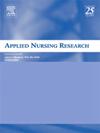Prevalence and types of fall-risk-increasing drugs identified by STOPPFall in hospitalized older adults: A retrospective observational study
IF 2.7
4区 医学
Q1 NURSING
引用次数: 0
Abstract
Background
Falls are a major public health concern, with fall-risk-increasing drugs (FRIDs) recognized as modifiable risk factors. The STOPPFALL— Screening Tool of Older Persons Prescriptions in older adults with high fall risk was recently developed to provide a comprehensive list of FRIDs, but few studies have assessed FRID prevalence using this tool.
Aim
This study aimed to describe the prevalence of FRIDs in a Swiss hospital, investigate changes in FRID prescription among patients identified by nurses at high risk of fall, and explore the association between FRID exposure and in-hospital falls.
Methods
This retrospective study analyzed health records of hospitalized patients over a one-year period. FRID prevalence at admission and discharge was assessed using the STOPPFall. Patients at risk of fall were identified based on the STRATIFY score. In-hospital falls were identified through incident reports.
Results
Of 741 participants, 44% (n = 332) were identified at high risk of fall, of whom 75% (n = 250) were prescribed at least one FRID at admission. The most frequently prescribed FRID classes were benzodiazepines, diuretics, and opioids. A significant reduction in FRID prescriptions was observed during hospitalization (p < 0.001). When high fall risk was documented by nurses, patients were less likely to be discharged with a FRID (p = 0.032). No significant association was found between FRID exposure and in-hospital falls.
Conclusion
Incorporating the STOPPFall into clinical practice could provide a structured framework to identify FRIDs, support the prioritization of patients for medication review, and improve medication safety in older adults.
STOPPFall在住院老年人中识别的跌倒风险增加药物的患病率和类型:一项回顾性观察性研究
跌倒是一个主要的公共卫生问题,增加跌倒风险的药物(frid)被认为是可改变的危险因素。STOPPFALL -老年人筛查工具最近开发了用于高跌倒风险老年人的处方,以提供FRID的综合清单,但很少有研究使用该工具评估FRID的患病率。目的本研究旨在描述瑞士一家医院FRID的流行情况,调查护士确定的跌倒高风险患者中FRID处方的变化,并探讨FRID暴露与院内跌倒之间的关系。方法回顾性分析住院患者一年以上的健康记录。使用STOPPFall评估入院和出院时的FRID患病率。根据STRATIFY评分确定有跌倒风险的患者。通过事故报告确定了院内跌倒。在741名参与者中,44% (n = 332)被确定为有跌倒的高风险,其中75% (n = 250)在入院时至少服用了一种FRID。最常见的FRID处方是苯二氮卓类药物、利尿剂和阿片类药物。住院期间观察到FRID处方显著减少(p <;0.001)。当护士记录有高跌倒风险时,患者出院时发生FRID的可能性较小(p = 0.032)。在FRID暴露和院内跌倒之间没有发现显著的关联。结论将STOPPFall纳入临床实践,可以为识别frid提供一个结构化的框架,支持患者用药审查的优先级,提高老年人的用药安全性。
本文章由计算机程序翻译,如有差异,请以英文原文为准。
求助全文
约1分钟内获得全文
求助全文
来源期刊

Applied Nursing Research
医学-护理
CiteScore
4.50
自引率
0.00%
发文量
65
审稿时长
70 days
期刊介绍:
Applied Nursing Research presents original, peer-reviewed research findings clearly and directly for clinical applications in all nursing specialties. Regular features include "Ask the Experts," research briefs, clinical methods, book reviews, news and announcements, and an editorial section. Applied Nursing Research covers such areas as pain management, patient education, discharge planning, nursing diagnosis, job stress in nursing, nursing influence on length of hospital stay, and nurse/physician collaboration.
 求助内容:
求助内容: 应助结果提醒方式:
应助结果提醒方式:


